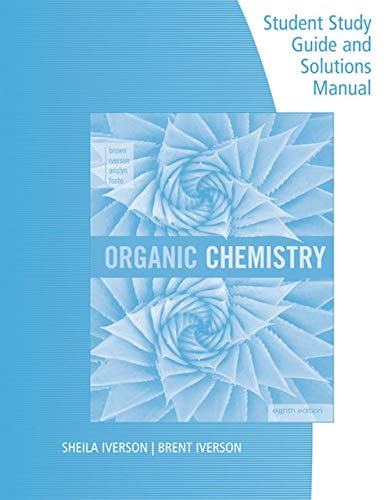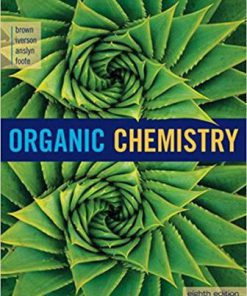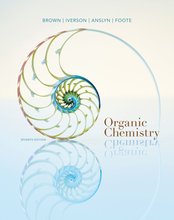Test Bank For Brown/Iverson/Anslyn/Foote’s Organic Chemistry, 8th Edition 8th Edition
$35.00 Original price was: $35.00.$26.50Current price is: $26.50.
Test Bank For Brown/Iverson/Anslyn/Foote’s Organic Chemistry, 8th Edition 8th Edition
Instant download Test Bank For Brown/Iverson/Anslyn/Foote’s Organic Chemistry, 8th Edition pdf docx epub after payment.

Product details:
- ISBN-10 : 1305580354
- ISBN-13 : 978-1305580350
- Author: William H. Brown; Brent L. Iverson
Master course concepts and improve problem-solving skills with ORGANIC CHEMISTRY, 8th Edition. This student-friendly text focuses on how to skills, and includes examples, problems, and end-of-chapter comprehensive study guides to help you prepare for exams. To help you understand reaction mechanisms, the authors offset them in a stepwise fashion and emphasize similarities between related mechanisms using just four different characteristics: breaking a bond, making a new bond, adding a proton, and taking a proton away. Thoroughly updated, the book offers numerous biological examples for premed students, unique roadmap problems, a wide range of in-text learning tools, and new author-created videos to help you excel.
Table Of Contents:
- Chapter 1: Covalent Bonding and Shapes of Molecules
- 1.1 Electronic Structure of Atoms
- 1.2 Lewis Model of Bonding
- 1.3 Functional Groups
- 1.4 Bond Angles and Shapes of Molecules
- 1.5 Polar and Nonpolar Molecules
- 1.6 Quantum or Wave Mechanics
- 1.7 A Combined Valence Bond and Molecular Orbital Theory Approach to Covalent Bonding
- 1.8 Resonance
- 1.9 Molecular Orbitals for Delocalized Systems
- 1.10 Bond Lengths and Bond Strengths in Alkanes, Alkenes, and Alkynes
- Study Guide
- Problems
- Things You Should Know I : General Conclusions from Quantum Mechanics
- Chapter 2: Alkanes and Cycloalkanes
- 2.1 The Structure of Alkanes
- 2.2 Constitutional Isomerism in Alkanes
- 2.3 Nomenclature of Alkanes and the IUPAC System
- 2.4 Cycloalkanes
- 2.5 Conformations of Alkanes and Cycloalkanes
- 2.6 Cis,Trans Isomerism in Cycloalkanes and Bicycloalkanes
- 2.7 Physical Properties of Alkanes and Cycloalkanes
- 2.8 Reactions of Alkanes
- 2.9 Sources and Importance of Alkanes
- Study Guide
- Problems
- Chapter 3: Stereoisomerism and Chirality
- 3.1 Chirality – The Handedness of Molecules
- 3.2 Stereoisomerism
- 3.3 Naming Chiral Centers – The R,S System
- 3.4 Acyclic Molecules with Two or More Stereocenters
- 3.5 Cyclic Molecules with Two or More Chiral Centers
- 3.6 Tying All the Terminology Together
- 3.7 Optical Activity – How Chirality Is Detected in the Laboratory
- 3.8 The Significance of Chirality in the Biological World
- 3.9 Separation of Enantiomers – Resolution
- Study Guide
- Problems
- Chapter 4: Acids and Bases
- 4.1 Arrhenius Acids and Bases
- 4.2 Bronsted-Lowry Acids and Bases
- 4.3 Acid Dissociation Constants, pKa, and the Relative Strengths of Acids and Bases
- 4.4 The Position of Equilibrium in Acid-Base Reactions
- 4.5 Thermochemistry and Mechanisms of Acid-Base Reactions
- 4.6 Molecular Structure and Acidity
- 4.7 Lewis Acids and Bases
- Study Guide
- Problems
- Chapter 5: Alkenes: Bonding, Nomenclature, and Properties
- 5.1 Structure of Alkenes
- 5.2 Nomenclature of Alkenes
- 5.3 Physical Properties of Alkenes
- 5.4 Naturally Occurring Alkenes – Terpene Hydrocarbons
- Study Guide
- Problems
- Things You Should Know II: Nucleophiles and Electrophiles
- Things You Should Know III: Reaction Mechanisms
- Chapter 6: Reactions of Alkenes
- 6.1 Reactions of Alkenes – An Overview
- 6.2 Organic Reactions Involving Reactive Intermediates
- 6.3 Electrophilic Additions
- 6.4 Hydroboration-Oxidation
- 6.5 Oxidation
- 6.6 Reduction
- 6.7 Molecules Containing Chiral Centersas Reactants or Products
- Study Guide
- Problems
- Chapter 7: Alkynes
- 7.1 Structure of Alkynes
- 7.2 Nomenclature of Alkynes
- 7.3 Physical Properties of Alkynes
- 7.4 Acidity of 1-Alkynes
- 7.5 Preparation of Alkynes
- 7.6 Electrophilic Addition to Alkynes
- 7.7 Hydration of Alkynes to Aldehydes and Ketones
- 7.8 Reduction of Alkynes
- 7.9 Organic Synthesis
- Problems
- Study Guide
- Chapter 8: Haloalkanes, Halogenation, and Radical Reactions
- 8.1 Structure
- 8.2 Nomenclature
- 8.3 Physical Properties of Haloalkanes
- 8.4 Preparation of Haloalkanes by Halogenation of Alkanes
- 8.5 Mechanism of Halogenation of Alkanes
- 8.6 Allylic Halogenation
- 8.7 Radical Autoxidation
- 8.8 Radical Addition of HBr to Alkenes
- Study Guide
- Problems
- Things You Should Know IV: Common Mistakes in Arrow Pushing
- Chapter 9: Nucleophilic Substitution and B-Elimination
- 9.1 Nucleophilic Substitution in Haloalkanes
- 9.2 Mechanisms of Nucleophilic Aliphatic Substitution
- 9.3 Experimental Evidence for SN1 and SN2 Mechanisms
- 9.4 Analysis of Several Nucleophilic Substitution Reactions
- 9.5 B-Elimination
- 9.6 Mechanisms of B-Elimination
- 9.7 Experimental Evidence for E1 and E2 Mechanisms
- 9.8 Substitution versus Elimination
- 9.9 Analysis of Several Competitions between Substitutions and Eliminations
- 9.10 Neighboring Group Participation
- Study Guide
- Problems
- Chapter 10: Alcohols
- 10.1 Structure and Nomenclature of Alcohols
- 10.2 Physical Properties of Alcohols
- 10.3 Acidity and Basicity of Alcohols
- 10.4 Reaction of Alcohols with Active Metals
- 10.5 Conversion of Alcohols to Haloalkanes and Sulfonates
- 10.6 Acid-Catalyzed Dehydration of Alcohols
- 10.7 The Pinacol Rearrangement
- 10.8 Oxidation of Alcohols
- 10.9 Thiols
- Study Guide
- Problems
- Chapter 11: Ethers, Epoxides, and Sulfides
- 11.1 Structure of Ethers
- 11.2 Nomenclature of Ethers
- 11.3 Physical Properties of Ethers
- 11.4 Preparation of Ethers
- 11.5 Reactions of Ethers
- 11.6 Silyl Ethers as Protecting Groups
- 11.7 Epoxides: Structure and Nomenclature
- 11.8 Synthesis of Epoxides
- 11.9 Reactions of Epoxides
- 11.10 Ethylene Oxide and Epichlorohydrin: Building Blocks in Organic Synthesis
- 11.11 Crown Ethers
- 11.12 Sulfides
- Study Guide
- Problems
- Chapter 12: Infrared Spectroscopy
- 12.1 Electromagnetic Radiation
- 12.2 Molecular Spectroscopy
- 12.3 Infrared Spectroscopy
- 12.4 Interpreting Infrared Spectra
- 12.5 Solving Infrared Spectral Problems
- Study Guide
- Problems
- Chapter 13: Nuclear Magnetic Resonance Spectroscopy
- 13.1 Nuclear Spin States
- 13.2 Orientation of Nuclear Spins in an Applied Magnetic Field
- 13.3 Nuclear Magnetic “Resonance”
- 13.4 An NMR Spectrometer
- 13.5 Equivalent Hydrogens
- 13.6 Signal Areas
- 13.7 Chemical Shift
- 13.8 Signal Splitting and the (n + 1) Rule
- 13.9 The Origins of Signal Splitting
- 13.10 Stereochemistry and Topicity
- 13.11 13C-NMR
- 13.12 Interpretation of NMR Spectra
- Study Guide
- Problems
- Chapter 14: Mass Spectrometry
- 14.1 A Mass Spectrometer
- 14.2 Features of a Mass Spectrum
- 14.3 Interpreting Mass Spectra
- 14.4 Mass Spectrometry in the Organic Synthesis Laboratory and Other Applications
- Study Guide
- Problems
- Chapter 15: An Introduction to Organometallic Compounds
- 15.1 Organomagnesium and Organolithium Compounds
- 15.2 Lithium Diorganocopper (Gilman) Reagents
- 15.3 Carbenes and Carbenoids
- Study Guide
- Problems
- Chapter 16: Aldehydes and Ketones
- 16.1 Structure and Bonding
- 16.2 Nomenclature
- 16.3 Physical Properties
- 16.4 Reactions
- 16.5 Addition of Carbon Nucleophiles
- 16.6 The Wittig Reaction
- 16.7 Addition of Oxygen Nucleophiles
- 16.8 Addition of Nitrogen Nucleophiles
- 16.9 Keto-Enol Tautomerism
- 16.10 Oxidation
- 16.11 Reduction
- 16.12 Reactions at an a-Carbon
- Study Guide
- Problems
- Chapter 17: Carboxylic Acids
- 17.1 Structure
- 17.2 Nomenclature
- 17.3 Physical Properties
- 17.4 Acidity
- 17.5 Preparation of Carboxylic Acids
- 17.6 Reduction
- 17.7 Esterification
- 17.8 Conversion to Acid Chlorides
- 17.9 Decarboxylation
- Study Guide
- Problems
- Things You Should Know V: Carboxylic Acid Derivative Reaction Mechanisms
- Chapter 18: Functional Derivatives of Carboxylic Acids
- 18.1 Structure and Nomenclature
- 18.2 Acidity of Amides, Imides, and Sulfonamides
- 18.3 Characteristic Reactions
- 18.4 Reaction with Water: Hydrolysis
- 18.5 Reaction with Alcohols
- 18.6 Reactions with Ammonia and Amines
- 18.7 Reaction of Acid Chlorides with Salts of Carboxylic Acids
- 18.8 Interconversion of Functional Derivatives
- 18.9 Reactions with Organometallic Compounds
- 18.10 Reduction
- Study Guide
- Problems
- Chapter 19: Enolate Anions and Enamines
- 19.1 Formation and Reactions of Enolate Anions: An Overview
- 19.2 Aldol Reaction
- 19.3 Claisen and Dieckmann Condensations
- 19.4 Claisen and Aldol Condensations in the Biological World
- 19.5 Enamines
- 19.6 Acetoacetic Ester Synthesis
- 19.7 Malonic Ester Synthesis
- 19.8 Conjugate Addition to a,B-Unsaturated Carbonyl Compounds
- 19.9 Crossed Enolate Reactions Using LDA
- Study Guide
- Problems
- Chapter 20: Dienes, Conjugated Systems, and Pericyclic Reactions
- 20.1 Stability of Conjugated Dienes
- 20.2 Electrophilic Addition to Conjugated Dienes
- 20.3 UV-Visible Spectroscopy
- 20.4 Pericyclic Reaction Theory
- 20.5 The Diels-Alder Reaction
- 20.6 Sigmatropic Shifts
- Study Guide
- Problems
- Chapter 21: Benzene and the Concept of Aromaticity
- 21.1 The Structure of Benzene
- 21.2 The Concept of Aromaticity
- 21.3 Nomenclature
- 21.4 Phenols
- 21.5 Reactions at a Benzylic Position
- Study Guide
- Problems
- Chapter 22: Reactions of Benzene and Its Derivatives
- 22.1 Electrophilic Aromatic Substitution
- 22.2 Disubstitution and Polysubstitution
- 22.3 Nucleophilic Aromatic Substitution
- Study Guide
- Problems
- Chapter 23: Amines
- 23.1 Structure and Classification
- 23.2 Nomenclature
- 23.3 Chirality of Amines and Quaternary Ammonium Ions
- 23.4 Physical Properties
- 23.5 Basicity
- 23.6 Reactions with Acids
- 23.7 Preparation
- 23.8 Reaction with Nitrous Acid
- 23.9 Hofmann Elimination
- 23.10 Cope Elimination
- Study Guide
- Problems
- Chapter 24: Catalytic Carbon-Carbon Bond Formation
- 24.1 Carbon-Carbon Bond-Forming Reactions from Earlier Chapters
- 24.2 Organometallic Compounds and Catalysis
- 24.3 The Heck Reaction
- 24.4 Catalytic Allylic Alkylation
- 24.5 Palladium-Catalyzed Cross-Coupling Reactions
- 24.6 Alkene Metathesis
- Study Guide
- Problems
- Chapter 25: Carbohydrates
- 25.1 Monosaccharides
- 25.2 The Cyclic Structure of Monosaccharides
- 25.3 Reactions of Monosaccharides
- 25.4 Disaccharides and Oligosaccharides
- 25.5 Polysaccharides
- 25.6 Glucosaminoglycans
- Study Guide
- Problems
- Chapter 26: Lipids
- 26.1 Triglycerides
- 26.2 Soaps and Detergents
- 26.3 Prostaglandins
- 26.4 Steroids
- 26.5 Phospholipids
- 26.6 Fat-Soluble Vitamins
- Study Guide
- Problems
- Chapter 27: Amino Acids and Proteins
- 27.1 Amino Acids
- 27.2 Acid-Base Properties of Amino Acids
- 27.3 Polypeptides and Proteins
- 27.4 Primary Structure of Polypeptides and Proteins
- 27.5 Synthesis of Polypeptides
- 27.6 Three-Dimensional Shapes of Polypeptides and Proteins
- Study Guide
- Problems
- Chapter 28: Nucleic Acids
- 28.1 Nucleosides and Nucleotides
- 28.2 The Structure of DNA
- 28.3 Ribonucleic Acids
- 28.4 The Genetic Code
- 28.5 Sequencing Nucleic Acids
- Study Guide
- Problems
- Chapter 29: Organic Polymer Chemistry
- 29.1 The Architecture of Polymers
- 29.2 Polymer Notation and Nomenclature
- 29.3 Molecular Weights of Polymers
- 29.4 Polymer Morphology – Crystalline versus Amorphous Materials
- 29.5 Step-Growth Polymerizations
- 29.6 Chain-Growth Polymerizations
- Study Guide
- Problems
- Appendix 1: Thermodynamics and the Equilibrium Constant
- Appendix 2: Major Classes of Organic Acids
- Appendix 3: Bond Dissociation Enthalpies
- Appendix 4: Characteristic 1H-NMR Chemical Shifts
- Appendix 5: Characteristic 13C-NMR Chemical Shifts
- Appendix 6: Characteristic Infrared Absorption Frequencies
- Appendix 7: Electrostatic Potential Maps
- Appendix 8: Summary of Stereochemical Terms
- Appendix 9: Summary of the Rules of Nomenclature
- Appendix 10: Organic Chemistry Reaction Roadmaps
- Glossary
- Index
People also search:
organic chemistry, 8th edition pdf
organic chemistry 8th edition solutions manual
organic chemistry












